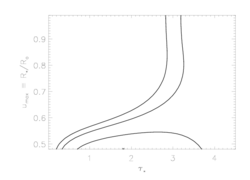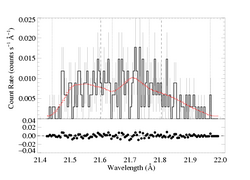O VII 21.602, 21.804 Angstroms
Non-porous models
Note: We fit only the MEG data. There are 225 MEG counts in the spectral region we fit (and plot below). See the fitting log. We fit the resonance and intercombination lines; the forbidden line isn't detected.
Continuum fit on 21.2:21.4 and 22.0:22.2. For n=2, best-fit norm=1.87e-3. The 68% confidence limits on the normalization are +/- 4e-4. And the best fit is formally a good fit.
Here are the 68%, 90%, and 95% joint confidence limits on taustar and uo. The asterisk represents the best-fit model, shown as the red histograms on the above plot.

|
Note that the global best-fit is at a significantly lower value of uo than we find for most lines. We made a second version of the confidence limit contour plot, showing smaller values of uo:

|
This is the same range we show in the confidence limit plot for the Ne VII Lyman alpha line.
Note that although values of uo < 0.5 (Ro > 2 R*) are mildly preferred, "standard" values of ~0.65 aren't even ruled out at the 90% confidence level.
Next, we fit isotropic porosity models to the data. And after that, anisotropic porosity models.
Back to main page.
last modified: 5 July 2008
